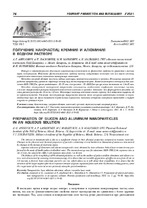| dc.contributor.author | Анисович, А. Г. | |
| dc.contributor.author | Ласковнев, А. П. | |
| dc.contributor.author | Маркевич, М. И. | |
| dc.contributor.author | Малышко, А. Н. | |
| dc.contributor.author | Журавлева, В. И. | |
| dc.coverage.spatial | Минск | ru |
| dc.date.accessioned | 2021-07-02T07:15:31Z | |
| dc.date.available | 2021-07-02T07:15:31Z | |
| dc.date.issued | 2021 | |
| dc.identifier.citation | Получение наночастиц кремния и алюминия в водном растворе = Preparation of silicon and aluminum nanoparticles in an aqueous solution / А. Г. Анисович [и др.] // Литье и металлургия. – 2021. – № 2. – С. 76-80. | ru |
| dc.identifier.uri | https://rep.bntu.by/handle/data/95925 | |
| dc.description.abstract | Интерес к наноматериалам обусловлен существенным изменением их физических свойств по сравнению с массивными материалами. Изменение физико-химических свойств частиц, содержащих несколько сот или тысяч атомов, определяется изменением плотности электронных состояний. Методом лазерной абляции получены водные растворы наночастиц алюминия и кремния. Импульсная лазерная обработка проводилась в режиме сдвоенных импульсов в дистиллированной воде. Вложенная энергия составляла для алюминия 1000–1500 Дж, время воздействия – 10–25 мин, для кремния – 50–1000 Дж при временах экспозиции от 1 до 10 мин. Методом сканирующей электронной микроскопии установлены особенности морфологии полученных частиц, а также поверхности кратеров поликристаллического алюминия и кремния. Показано, что формируется ансамбль частиц разного размера от 20 нм до 2,0 мкм. Некоторые частицы алюминия имеют огранку, что позволяет говорить об их кристалличности. Показано, что структура поверхности мишени после лазерного воздействия состоит из зерен, отделенных друг от друга канавками термического травления, поскольку испарение материала происходит в первую очередь по границам зерен. | ru |
| dc.language.iso | ru | ru |
| dc.publisher | БНТУ | ru |
| dc.title | Получение наночастиц кремния и алюминия в водном растворе | ru |
| dc.title.alternative | Preparation of silicon and aluminum nanoparticles in an aqueous solution | ru |
| dc.type | Article | ru |
| dc.identifier.doi | 10.21122/1683‑6065‑2021‑2‑76‑80 | |
| local.description.annotation | The interest in nanomaterials is due to a significant change in their physical properties compared to massive materials. Changes in the physical and chemical properties of particles containing several hundred or thousands of atoms are determined by changes in the density of electronic states. Aqueous solutions of aluminum and silicon nanoparticles were obtained by laser ablation. Pulsed laser treatment was performed in the mode of double pulses in distilled water. The invested energy was: for aluminum 1000–1500 J, the exposure time is 10–25 min., for silicon-50–1000 J with exposure times from 1 to 10 min. The features of the morphology of the obtained particles, as well as the surface of polycrystalline aluminum and silicon craters, were determined by scanning electron microscopy. It is shown that an ensemble of particles of different sizes from 20 nm to 2.0 microns is formed. Some aluminum particles are cut, which allows us to talk about their cristallinity. It is shown that the structure of the target surface after laser exposure consists of grains separated from each other by thermal etching grooves, since the evaporation of the material occurs primarily along the grain boundaries. | ru |

